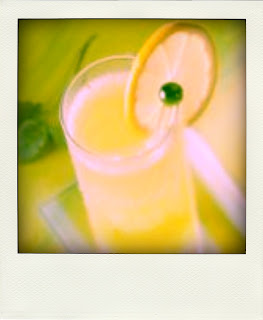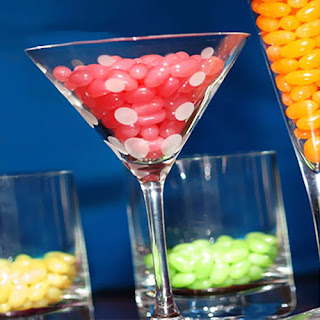Why do we drink cocktails out of
cocktail glasses? I agree that they look
pretty; moreover, the triangle is one of my favorite shapes, something that the
cocktail glass deploys to terrific effect.
But it's just not terribly stable. And especially when one gets to the
second cocktail or to the point where conversation calls for particularly
emphatic gesticulation, the imbiber (at least those of less than Olympically
gymnastic hand-eye coordination) quickly finds him- or herself working hard to
manage the preservation of delectable concoction within the cocktail glass's
mercurial embrace.
At risk of sounding positively heretical, would not the ordinary wine glass
do all of the requisite tasks better? Or, perhaps more radically, could we
design some finer, more appropriate serving vessel?
A well-stocked bar not only requires different types of drinks, but also
coordinating glasses and barwarefor serving various beverages. While most drinks
have traditional glassware, you can be as creative as you want with your
cocktail glasses. Mix and matchglasses and barware or choose unique cocktail
glasses to reinvent your favorite drinks. Cocktail glasses can also be used for
nonalcoholic beverages, such as bubbling punches and sparkling cider. To make
sure you have enough bar glasses for all your guests, plan for one to two
glasses per person for each beverage served at an event or party.
Highball and lowball glasses: The tall, straight highball glass typically
holds between 12 and 14 ounces of liquid. The base and rim of the glass are the
same size. Highball glasses are often used to serve Bloody Marys and mixed
drinks such as cranberry and vodka or gin and tonic. Drinks served in highball
glasses are commonly served with ice. Lowball glasses are smaller than the
highball, holding between 8 to 10 ounces of alcohol. Lowball glasses are
commonly used to serve mixed drinks or a couple ounces of fine whiskey or
scotch, served neat or on the rocks.
Martini glass: Also referred to as the classic cocktail glass, the martini
glass has a slim stem and a wide, cone-shaped bowl. The cone shape of the bowl
helps to keep ingredients from separating. Martini glasses are used to serve
martinis, Manhattans, gimlets and various mixed drinks.
Shot glass: The smallest cocktail glass is the shot glass, or shooter. The
ingredients of the shot glass are intended to be consumed in one swallow. The
average shot glass contains 1.5 ounces of alcohol. Straight whiskey, vodka and
other liquors are served in the shot glass. Some shot glasses include decorative
embellishments, labels and pictures.
Wine glass: This thin, elegant stemmed glass is used for various wines. Red
wine glasses have wider bowls to increase oxidation, while white wine glasses
are slightly narrower. Wine glasses are meant to be held by the stem so as not
to change the temperature of the wine. It is also important to hold the glass by
the stem to avoid fingerprints on the glass, which can be distracting when
looking at color and clarity of the wine.
Champagne flute: Made to serve sparkling wine, the flute is an elegant,
ultra-slim goblet. The elongated shape of the glass prevents the champagne or
other carbonated beverage from going flat; the long shape lets bubbles rise
slowly, adding to the visual effect of the drink. Besides champagne, you can
serve mimosas, champagne cocktails and even sparkling water in champagne
flutes.
Brandy snifter: Unlike other types of stemware, the bowl of the brandy
snifter is meant to be held in the palm of the hand in order to warm the brandy
or cognac. The glass has a wide base and a smaller rim, allowing the aroma to
linger in the top portion of the glass and not escape.
The reason we drink Bordeaux, for example, from tall, bell-shaped glasses
which taper toward the top (other than elegant appearance) is that the shape
focuses the flow of vapor. This is all quite helpful when your nose is eager to
gambol across meadows of subtle aroma, and the alcohol (by volume) is unlikely
to exceed 14 percent. Tasting from this type of glass is the equivalent of
turning up the volume.
When approaching the classic 40 percent liquor proof, however, the same
level of magnification is more than enough to scorch nasal passages. Imagine
cranking up the volume on a 747.
Of course, I realize I've gone on and on about the practical, and only
ended up smuggling in the aesthetic along the way. There's a good bit more to be
said on that subject, though, so please let me know if I haven't scribbled you
cross-eyed already. Also, your proposal of a new vessel is intriguing, and we
should discuss it further. In the meantime, regardless of which vessel you
choose, may all of your concoctions bedazzle and delight.
And how do you feel about the cocktail glass, gentle reader? Does it make
you feel majestic, or anxious? Do you wear your Martinis up or down? (Surly and
warlike readers are also welcomed to respond, but I find the gentle ones require
more coaxing.)































